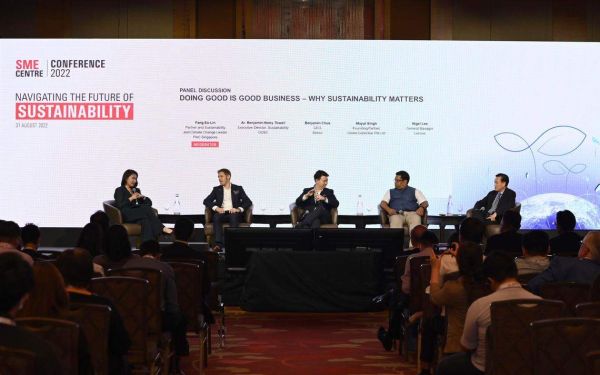SMALL and medium-sized enterprises (SMEs) and multinational corporations (MNCs) play an equal role in advancing the sustainability agenda and should work together to do so, said panellists at a discussion held at the SME Centre Conference on Wednesday (Aug 31).
“We all have a responsibility, no matter the size,” said Benjamin Henry Towell, executive director of sustainability at OCBC. “A large corporation uses a whole supply chain of SMEs, and so the relationship between them is quite fluid. Both the SME and MNC need to work together when it (concerns) a whole supply or value chain.”
Similarly, Nigel Lee, general manager of PC vendor Lenovo, said that sustainability was not an individual effort. “In the past, sustainability was about pushing the responsibility to the end-user; now, sustainability is about putting the responsibility on the manufacturer to produce really sustainable products. So we need to connect the dots.”
He noted how Lenovo’s success is dependent on the success of its supply chain partners: “This is a critical part for SMEs, regardless of whether you’re in supply chain or logistics…in the short run, it’s going to impact us one day or the other. So I think the journey has to start with them.”
Benjamin Chua, chief executive of cleaning technology company Speco, said companies should tap the whole ecosystem of partners, including trade chambers and associations. “The opportunities for us to collaborate are out there, especially for SMEs, and we should huddle together as a pack.”
Towell noted that banks can serve as a conduit by connecting solutions providers to customers looking for solutions. “We bank the supply side; we have the demand side as well. So being able to link up those various parts of the ecosystem together to provide their solutions has been very useful, and we’re seeing that in all the different industries.”
Banks can also provide sustainable linked loans to help SMEs transition to becoming greener businesses, Towell added. “There would be targets on greenhouse gas emissions, so in 5 years, you’ll reduce it by, say, 40 per cent year on year and we’ll provide the capital to do that.”
Meanwhile, companies that have been most successful in meeting sustainability goals are those with employees who have fully “internalised” the firm’s sustainability strategy, noted Mayur Singh, co-founder of Green Collective, a collective of sustainable retail brands.
“There are 2 sets of companies: one where employees fully understand what the sustainability roadmap means for the company and its stakeholders, while the other one is where internalisation has not happened in a very good way. It’s more like the KPI is done by the sustainability team.”
He cited the example of outdoor clothing retailer Patagonia, which recruits employees that share the brand’s values of sustainability.
“It’s actually very important to align (at this level), because you have a lot of network effects, which then lead to ideas coming not just from the top to bottom level, but (vice versa). And that is where you can drive a lot of the synergies that value add to sustainability.”
There are many ways for companies to harness this culture of “environmental leadership”, Singh added.
This includes organising talks and workshops, getting employees to form “green teams” - which refers to a group of employees coming together to advance sustainability within the organisation - and even constructing hydroponics walls in the office.
“That belief system that is created within employees can go a very long way in delivering the highest sustainability objectives that the board of your company wants to actually achieve.”
Source: The Business Times
Link: Here
September 29, 2022













